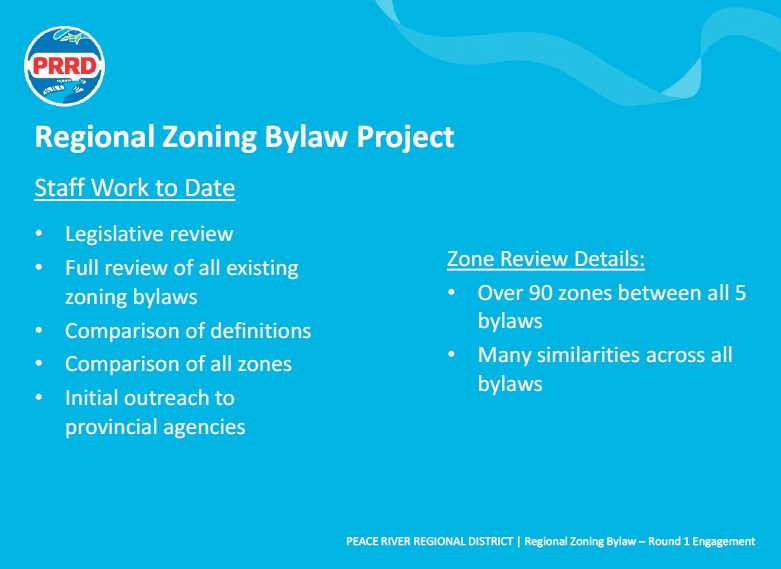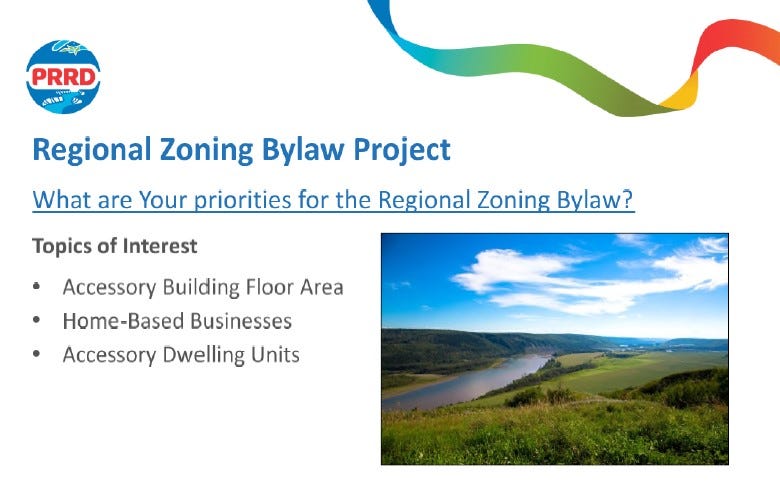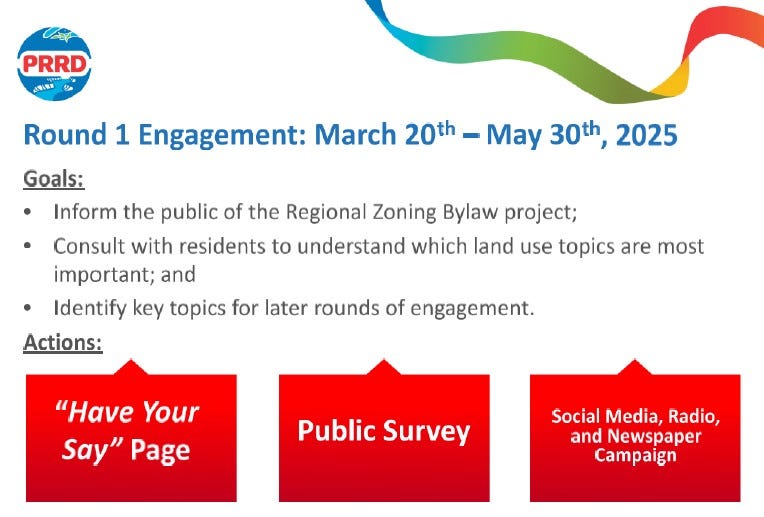Proposed bylaw a behemoth: Director says all landowners should be consulted
In its efforts to modernize the current collection of zoning bylaws into one, Peace River Regional District Area E Director Dan Rose cautions against forgetting that the current zoning bylaws reflect the unique differences in various areas of the Regional District.
“I believe there is a reason to modernize, just for the sake of getting business done in a timely fashion, we need to amalgamate for sure, but not at the expense of the individuality of different areas of our region,” Rose said.
Almost two years ago, in May 2023, the PRRD board of directors asked staff to look into developing a new Regional Zoning Bylaw. This new bylaw is intended to replace the existing five zoning bylaws, some of which date back to 1976. Regional District staff says this initiative will create one unified bylaw to better serve regional communities.
Creating this all-encompassing bylaw is a huge undertaking, it’s a behemoth, says Ashley Murphey, PRRD’s General Manager of Development Services, who presented the Zoning Bylaw Project to the board along with Planner 3, Devin Cronin on March 20.
“We’re moving to a regional bylaw versus right now we have five bylaws that cover different portions of the regional district,” Murphey said. “We’re still early days in the process.”
So far, regional district staff have reviewed all the current zoning bylaws, compared zones and definitions, reviewed legislation and reached out to relevant provincial agencies.
In addition, a survey has been launched on the PRRD’s Have Your Say website to gather public input on what residents would like addressed in the new bylaw. The survey runs from March 20 to May 30, 2025.
The survey questions cover things such as the sizes of shops that should be allowed on various size of properties, what types of home-based businesses should be permitted in rural areas, along with questions about secondary suites in accessory buildings and how many dwellings should be allowed on rural properties.
The PRRD says the new bylaw will bring benefits including improved accessibility, updated regulations based on community feedback and less red tape to support local industries. However, there are no questions related to these areas on the survey.
Once all the data has been completed, a What We Heard report will be presented to the Board, followed by staff review of survey submissions and a plan for in-person engagement crafted. As the survey is open until May, in-person engagement with rural residents is likely to take place in the Fall.
Area C Director Brad Sperling questioned why no public engagement is listed in Round 1 of the project.
“A lot of our rural people don’t have access to internet, some don’t use our get engaged page and that sort of thing. Shouldn’t they run concurrently,” he asked. “A lot of rural people don’t have access or may have access but don’t know how to use the get engaged page. It just seems that they should be run together.”
Sperling noted that the town hall meetings have always been run at the same time during these types of engagements, which has worked well, with people being able to go there and converse with each other.
“I can’t say what my residents’ priorities are if I’m not hearing what they’re saying,” Sperling said. “Town halls have always worked, especially for our rural residents.”
“I want to hear what my residents and the other rural residents have to say.”
Murphey says the survey is the initial step, and there is also a print version of the survey available.
“The survey is the initial step to get some preliminary feedback to help us craft the draft bylaw. Once that draft bylaw is in its draft form, that’s when we’re intending to go out in-person to the public and have those in-person meetings,” she explained.
Dawson Creek Director Darcy Dober, Tumbler Ridge Director Darryl Krakowka, and Fort St. John Director Lilia Hansen all felt that the proliferation of Development Variance Permit requests is an indication of what residents want to see.
For example, Hansen says she hears a lot about accessory buildings and surmised that people want to shelter their belongings and keep them safe.
Dober felt that the greatest tool the board has for communication is the variance requests and “that’s the reason why we decided to move this forward and get the regional district team to look at it, because of the amount of variance requests.”
“To me that’s listening to our constituents,” he said.
Rose, who has been a member of the PRRD board for many years, says differently.
“In spite of what the current board think, it isn’t due to all the variances. This has been in the works for years, because of the multitude of different zoning bylaws that we have,” Rose said.
Originally, Rose said, when the board started talking about this, it was about an amalgamation of the existing bylaws.
“This is huge, and a lot of people don’t even realize what their zoning is, what it means and what the regulations are,” he said.
“Unfortunately, I don’t think we can not afford to spare expense to reach out to every landowner that has zoning so they understand what it is, and what the changes might be, and how they feel about that.”
Rose added that instead of just coming back to the full board with reports, staff should attend the Electoral Area Directors Committee whenever they have something to share, so that the rural directors have that information.
“We really have to think about how we’re going to reach out to everybody, because it affects everybody."
Board Chair and Area D Director Leonard Hiebert agreed.
“It’s going to be hard to reach everybody, but we should attempt to get to everybody because, he’s [Director Rose] right, a lot of them don’t know what zoning they’re in right now.”
At least not until they apply to build something, and then they find out what their zoning is and what they can or cannot do, Hiebert added.
Sperling said he is worried about getting word out to the unincorporated communities, whose residents don’t necessarily have access to the internet.
“We always worry about time and money, but not at the expense of the public’s time to comment on something this large and important.”
Murphey said that in addition to advertising the survey on social media, the PRRD will be running radio and newspaper ads. She noted that the Northern Horizon newspaper goes to most rural mailboxes. As she also mentioned, paper copies of the survey are available at the Dawson Creek and Fort St. John PRRD offices.







